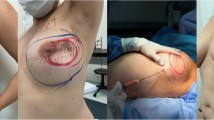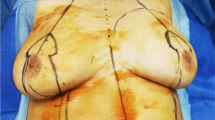Abstract
Current techniques for augmentation mammoplasty involve the use of alloplastic materials and an open approach. The former may not be well tolerated and often can be the origin of undesirable effects such as capsule contracture. The latter implies residual scars, which can sometimes be less than satisfactory from an esthetic point of view. Considering all the problems mentioned above and seeking to find safe and reliable alternatives to implants, we focused our attention on the possibility of using fat tissue as filling material for breast augmentation. Autologous adipose tissue has been used to correct soft tissue defects for more than a century. Its soft and natural texture, the absence of a line, and its versatility have always made adipose tissue the ideal physiologic filling material. The author describes his surgical experience with breast fat transfer. The clinical outcome described in this Article is based on over 800 patients with a follow-up period of over than 26 years. The surgical techniques described by the author evolved constantly and steadily aiming to achieve more consistent results and trying to increase at the same time patient safety and satisfaction. Analyzing the clinical data clearly appears that complications are strictly related to the oily content of the transplanted tissue, where more TGs in the recipient site is clearly at the origin of a higher level of complications. In order to improve patient’s safety and to limit risk of side effects, the author developed a new “oil-free” fat transfer technique. All the technical steps are described in details. An important part of this work is dedicated to a careful evaluation of safety aspects and oncologic concerns. The total oncologic safety of fat transfer in breast reconstruction and in esthetic augmentation has been clearly proved and confirmed.
Level of Evidence: Level IV, therapeutic study.


















Similar content being viewed by others
References
Baker JL Jr, Bartels RJ, Douglas WM (1976) Closed compression technique for rupturing a contracted capsule around a breast implant. Plast Reconstr Surg 58:137–141
Baker JL (1989) Augmentation mammoplasty, a personal approach. In: Marsh JL, editor. Current Therapy in Plastic and Reconstructive Surgery. Mosby-Year Book:1–9
Becker H (1988) Expansion augmentation. Clin Plast Surg 15:587–93.4
Berrino P, Casabona F, Santi P (1988) Long-term advantages of permanent expandable implants in breast aesthetic surgery. Plast Reconstr Surg 101:1964–1972
Blugerman G, Sharelzon D, Wexlex G et al (2016) Carbon dioxide-assisted pneumodissection in fat grafting. Am J Cosm Surg 33:58–68
Brinton LA, Brown SL, Colton T et al (2000) Characteristics of a population of women with breast implants compared with women seeking other type of plastic surgery. Past Reconstr Surg 105:919–927
Carlson GW, Curley SA, Martin JE et al (1993) The detection of breast cancer after augmentation mammaplasty. Plast Reconstr Surg 91:837–840
Coleman SR (1997) Facial recontouring with lipostructure. Clin Plast Surg 24:347–367
Coleman SR (2006) Structural fat grafting: more than a permanent filler. Plast Reconstr Surg 118(3 Suppl):108S–1020
Courtiss EH, Goldwyn RM, Anastasi GW (1979) The fate of breast implants with infections around them. Plast Reconstr Surg 63:812–816
Cronin TD, Gerow FJ (1963) Augmentation mammaplasty: a new “natural feel” prosthesis. Excerpta Medica International Congress Series 66:41
Czerny V (1895) Plastischer Ersatz der Brustdruse durch ein Liporna. Chir Kongr Verhandl 2:216
Deapen D, Hamilton A, Bernstein L et al (2000) Breast cancer stage at diagnosis and survival among patients with prior breast implants. Plast Reconstr Surg 105:535–540
Deapen DM, Brody GS (1992) Augmentation mammaplasty and breast cancer: a 5 year update of the Los Angeles study. Plast Reconstr Surg 89:660–665
Farina MA, Newby BG, Alani HM (1980) Innervation of the nipple-areola complex. Plast Reconstr Surg 66:497–501
Fournier P (1986) La liposculture. In: Laffont R (ed). Paris
Fournier P (1985) Microlipoextraction et microlipoinjection. Rev Chir Esthet Fr 41
Gabriel SE, O’Fallon WM, Kurland LT et al (1994) Risk of connective-tissue diseases and other disorders after breast implantation. N Engl J Med 330:1697–1702
Georgiade NG, Georgiade GS, Riefkohl R (1990) Esthetic breast surgery. In: McCarthy JG (ed) Plastic surgery, Vol. 6. W.B. Saunders, Philadelphia, pp 3839–3896
Goldwyn R (1976) Plastic and reconstructive surgery of the breast. Little Brown & Co., Boston
Handel N, Jensen JA, Black Q et al (1995) The fate of breast implants: a critical analysis of complications and outcomes. Plast Reconstr Surg 96:1521–1533
Hayes H, Vandergrift J, Diner WC (1988) Mammography and breast implants. Plast Reconstr Surg 82:1–8
Hidalgo DA (2000) Breast augmentation: choosing the optimal incision, implant and pocket plane. Plast Reconstr Surg 105:2202–2216
Illouz YG (1986) The fat cell graft. A new technique to fill depressions Plast Reconstr Surg 78:122
Jones FR, Tauras AP (1973) A periareolar incision for augmentation mammoplasty. Plast Reconstr Surg 51:641–644
Kronowitz SJ, Mandujano CC, Liu J et al (2016) Lipofilling of the breast does not increase the risk of recurrence of breast cancer: a matched controlled study. Plast Reconstr Surg 137:385–393
Laufer E (1997) Fibrous bands following subpectoral endoscopic breast augmentation. Plast Reconstr Surg 99:257
Leibman AJ, Kruse BD (1993) Imaging of breast cancer after augmentation mammoplasty. Ann Plast Surg 30:111–115
Lejour M (1997) Evaluation of fat in breast tissue removed by vertical mammoplasty. Plast Reconstr Surg 99:386–393
Lejour M (1994) Vertical mammoplasty and liposuction of the breast. Plast Reconstr Surg 94:100–14.
Little G, Baker JL Jr (1980) Results of closed compression capsulotomy for treatment of contracted breast implant capsules. Plast Reconstr Surg 65:30–33
Mofid MM, Klatsky SA, Singh NK (2006) Nipple-areola complex sensitivity after primary breast augmentation: a comparison of periareolar and inframmammary incision approaches. Plast Reconstr Surg 117:1694–1698
Neuber F (1893) Fettransplantation. Chir Kongr Verhandl Dsch Geselsch Chir 22:66
Park AJ, Black RJ, Sarhadi NS et al (1998) Silicone gel-filled breast implants and connective tissue diseases. Plast Reconstr Surg 101:261–268
Peer LA (1950) Loss of weight and volume in human fat grafts with postulation of “cell survival theory”. Plast Reconstr Surg 5:217
Petit JY, Le MG, Mouriesse H et al (1994) Can breast reconstruction with gel-filled silicone implants increase the risk of death and second primary cancer in patients treated by mastectomy for breast cancer? Plast Reconstr Surg 94:115–119
Price CI, Eaves FF, Nahai F et al (1994) Endoscopic transaxillary subpectoral breast augmentation. Plast Reconstr Surg 94:612–619
Radovan C (1982) Breast reconstruction after mastectomy using the temporary expander. Plast Reconstr Surg 69:195–208
Rigotti G, Marchi A, Galiè MM et al (2007) Clinical treatment of radiotherapy tissue damage by lipoaspirate transplant. A healing process mediated by adipose-derived adult stem cells. Plast Reconstr Surg 119:1409–1422
Silverstein MJ, Gamagami P, Handel N (1990) Missed breast cancer in an augmented woman using implant displacement mammography. Ann Plast Surg 25:210–213
Slade CL, Peterson HD (1982) Disappearance of the polyurethane cover of the Ashley natural Y prothesis. Plast Reconstr Surg 70:379–383
Spear SL, editor. Surgery of the breast: principles and art. Philadelphia: Lippincott, Williams, and Wilkins; 1998. p. 845–917.
Spear SL, Bowen DG (1998) Secondary surgery and silicone implants: one center’s experience before and after the FDA hearing of 1991 and 1992. Aesthet Surg J 18:167–184
Tarpila E, Ghassemifar R, Fagrell D et al (1997) Capsular contracture with textured versus smooth saline-filled implants for breast augmentation: a prospective clinical study. Plast Reconstr Sur 99:1934–1939
Tebbetts JB (1988) Transaxillary subpectoral augmentation mammaplasty: a 9-year experience. Clin Plast Surg 15:557–568
Tebbetts JB (1984) Transaxillary subpectoral augmentation mammaplasty: long-term follow-up and refinements. Plast Reconstr Sur 74:636–649
Toledo LS, Mauad R (2006) Fat injection: a 20-year resivion. Clin Plast Surg 33:47–53
Valdatta L, Thione A, Buoro M et al (2001) A case of life-threatening sepsis after breast augmentation by fat injection. Aesthetic Plast Surg 25:347–349
Weisman MH, Vecchione TR, Albert D et al (1988) Connective-tissue disease following breast augmentation: a preliminary test of the human adjuvant disease hypothesis. Plast Reconstr Surg 82:626–630
Wells KE, Cruse CW, Baker JL et al (1994) The health status of women following cosmetic surgery. Plast Reconstr Surg 93:907–912
Zocchi ML (1989) Les implant mixte de collagène autologue dans le remodelage facial. Rev Chir Esthét Fr 14:37–48
Zocchi ML (1989) Remodelage facial complet par implants de collagène autologue. Rev Chir Esthét Fr 14:63
Zocchi ML (1990) Méthode de production de collagène autologue par traitement du tissue graisseux. Jour Med Esthét Chir Dermatol 17:60
Zocchi ML. Stem cells from fat. Abstract book of 10th Annual Meeting of the Turkish Society of Aesthetic Plastic Surgery; June 2006.
Zocchi ML. New perspectives in plastic surgery: adipose derived stem cells (A.D.S.C.). Abstract Book of the I.S.A.P.S. World Congress of Rio de Janeiro; August 2006.
Zocchi ML (2006) New perspectives in plastic surgery: adipose derived stem cells (ADSC). Abstract Book of the ISAPS. World Congress, Rio de Janeiro, p 88–91
Zocchi ML (2007) Bicompartmental breast lipostructuring. In: Botti G (ed) Aesthetic mammoplasties. SEE, Florence
Zocchi ML (2008) Aesthetic Mammaplasties (SEE - Florence):279–299
Zocchi ML, Zuliani F (2008) Bicompartmental breast lipostructuring. Aesthetic Plast Surg 32:313–328
Zocchi ML (1992) Ultrasonic liposculpturing. Aesthetic Plast Surg 16:287–298
Zocchi ML (1993) Clinical aspects of ultrasonic liposculpture. Perspect Plast Surg 7:153–174
Zocchi ML (1995) Ultrasonic assisted Lipectomy. Adv Plast Reconstr Surg 11:197–221
Author information
Authors and Affiliations
Corresponding author
Ethics declarations
Conflict of interest
Michele L. Zocchi and Lamberto Zocchi declare that they have no conflict of interest.
Ethical approval
For this kind of retrospective study formal consent from a local ethics committee is not required.
Informed consent
All the patients treated had duly fulfilled and undersigned informed consent as per Italian Law.
Patient consent
Patients provided written consent before their inclusion in this study.
Rights and permissions
About this article
Cite this article
Zocchi, M.L., Zocchi, L. Large-volume breast fat transfer: technical evolutions and safety aspects based on over 800 cases and 26 years of follow-up. Eur J Plast Surg 40, 367–382 (2017). https://doi.org/10.1007/s00238-017-1339-2
Received:
Accepted:
Published:
Issue Date:
DOI: https://doi.org/10.1007/s00238-017-1339-2




